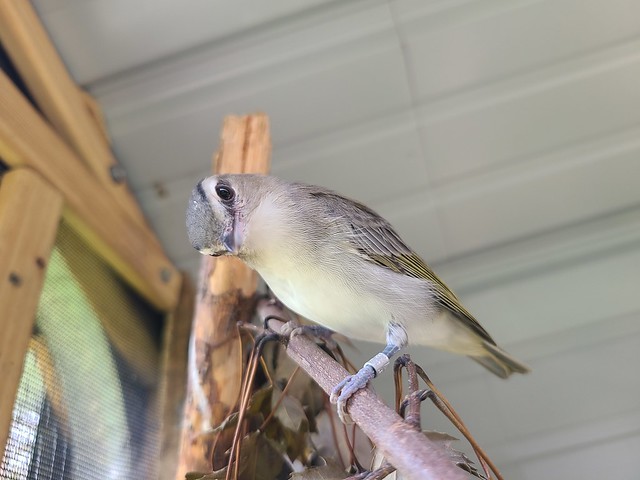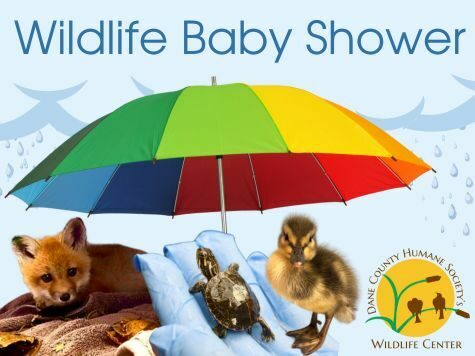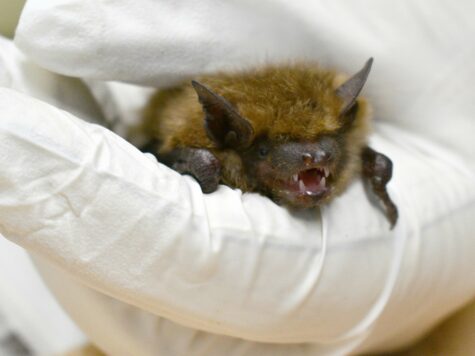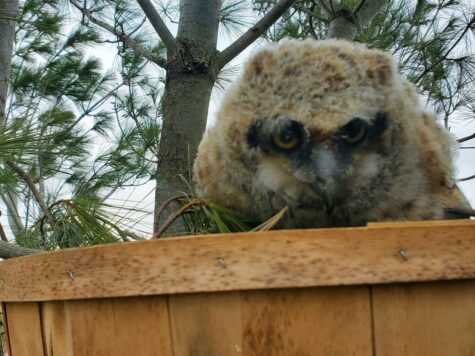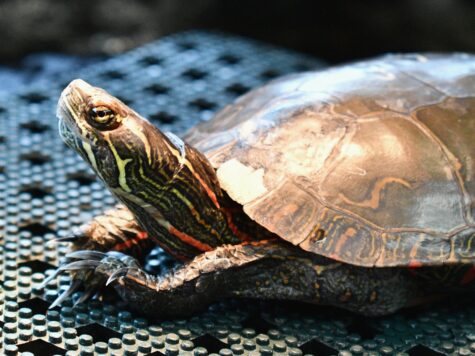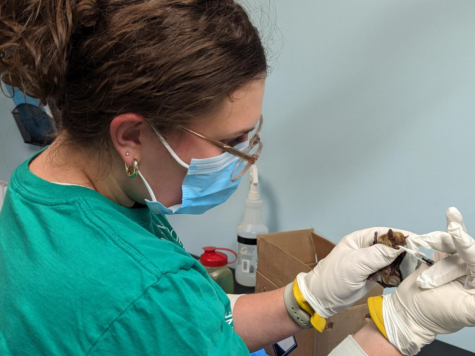Below is Dane County Humane Society’s Wildlife Training Supervisor Jackie Sandberg’s account of the bird that arrived for care and left with the love and respect of everyone who helped it.
Here at Dane County Humane Society’s Wildlife Center, we see thousands of songbirds every year. Many of us on staff think back to the one-eyed golden-crowned kinglet who was successfully released after a complex eye surgery, or maybe we remember the back-to-back yellow-billed cuckoos who ate us out of house and home during the winter months. However, none of us will forget the red-eyed vireo baby from 2021 that stole our hearts and made us proud to be called wildlife rehabilitators.
This small, foliage-gleaning insectivore was admitted on July 19th after being found on the sidewalk in downtown Brookfield, Wisconsin, unable to move. Normally, we would refer a caller to the closest licensed rehabilitator, but the COVID-19 pandemic and staffing shortages had caused other nearby centers to limit their intake. DCHS Wildlife Center was the next closest facility, so either fate or chance brought this bird to our doors.
On its first exam, we noted this little ball of fluffy feathers as bright, alert, and responsive, but it was significantly dehydrated. We also soon deemed it an escape artist. Yes, you read that correctly: it could fly and dart out of any container. We concluded this could be a young fledgling that had fallen from its nest in a perilous urban location, and it would probably fare well for us if it could learn how to eat and find food appropriate for a vireo.
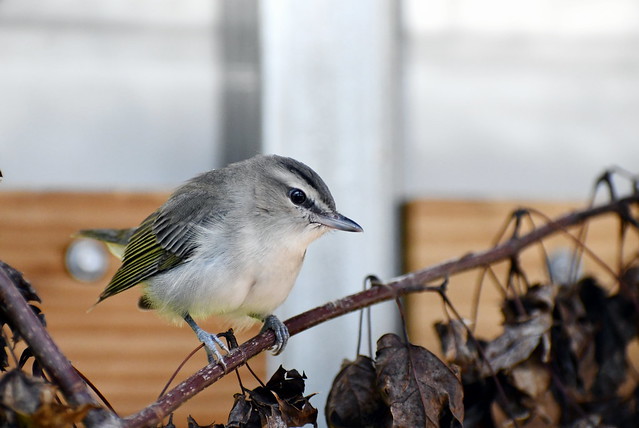
Vireos are a unique species known for flying around the tops of trees to expertly catch bugs, moths, spiders, and other insects. This bird had a lot of learning ahead; it would take the next month and a half of thirty-minute hand-feedings, followed by flight testing and staff evaluations in an outdoor enclosure, until we felt it could be released back into the wild.
When this bird was moved outside to a pre-release cage, it was amazing to watch it share its space with other species, namely our barn swallows, cliff swallows, and chimney swifts. Sometimes it would stay with the swifts, roosting overnight in their chimney, as if it enjoyed spending its time around other birds. Other times, it would join the swallows on a branch, sitting right next to the others without much inhibition. It seemed to us that it liked the company, which made sense for a species that is known for being found in larger diverse groups of songbirds in the wild. According to research compiled by the University of Michigan’s BioKIDS research group, vireos are primarily nocturnal and “will join mixed species groups or groups with up to 30 other vireos.”
Each day, we would watch this vireo flutter and vibrate excitedly for food when presented, gaping for insects, until it was finally seen obtaining food on its own. With the help of a research-grade insect collection system, each night we would collect hundreds of local bugs to release into the enclosure. We could see the vireo flying around and chasing those bugs, and finally it was successfully maintaining body weight.
By the time it was ready for release, it was demonstrating normal behaviors, such as catching and smooshing the bugs in a way that was appropriate for its species – trust me, you want to see the video footage. It would sometimes bring an insect up close, almost as if it was showing off what it could do, and we would stare in awe – it’s an experience you never forget, nor usually see unless you are a rehabilitator.
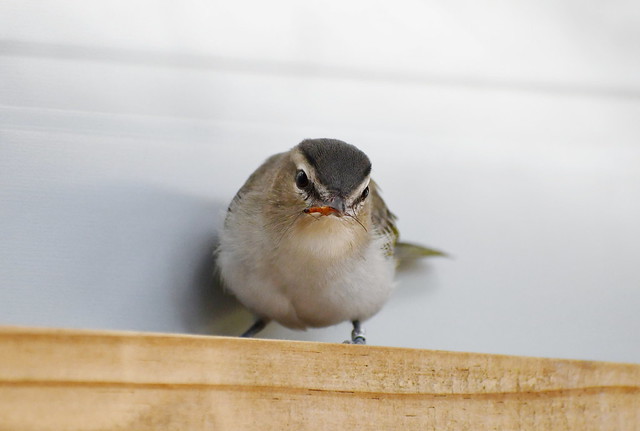
On August 30th, the vireo was federally banded and released. We elected to let it go on DCHS property. This is a species that would migrate south, and our property was full of adequate insect populations for it to eat until then. We thought it would be helpful to monitor it ourselves, assuming it stayed around the area.
We hope that this red-eyed vireo lives a long and successful life after its time at the Wildlife Center. We will never forget how fun it was to hand-rear a common, yet unique, songbird species like this one!
Thanks to supporters like you, DCHS’s Wildlife Center has been able to care for over a thousand ill, injured, or orphaned wildlife so far this year, including the mischievous red-eyed vireo. When you donate today, your gift has DOUBLE the impact thanks to our generous matching gift. Thank you for donating and helping us save wildlife.
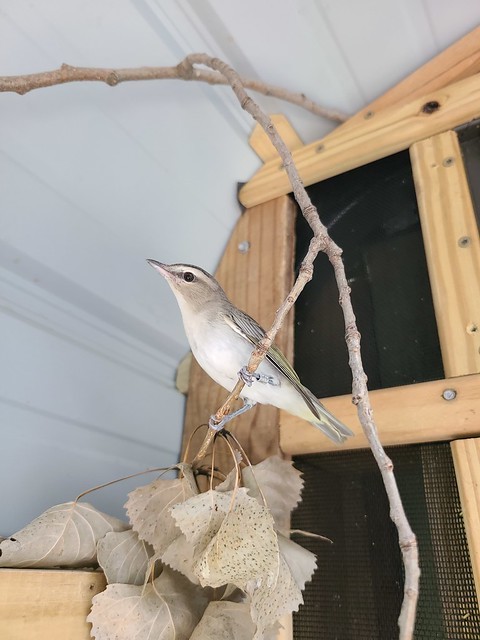
Thank you for your generosity and patience! Due to all the support of DCHS this Giving Tuesday, our donation form below may take a minute or two to load.
